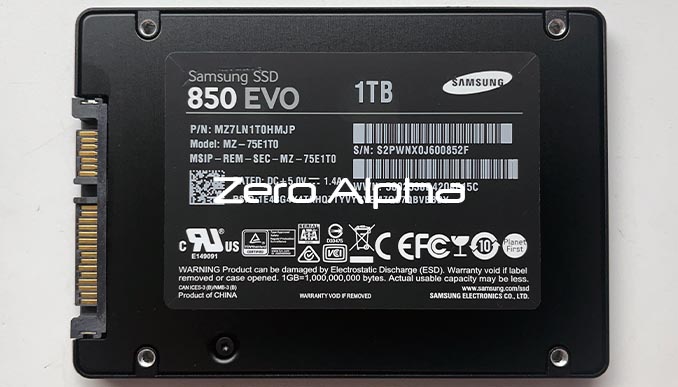Samsung 850 EVO 1TB SSD Data Recovery
Samsung 850 EVO 1TB SSD data recovery service by Zero Alpha. Below, we outline the most common issues associated with this SSD that may necessitate data recovery.

1. NAND Flash Wear
The 850 EVO uses NAND flash memory, which has a limited lifespan determined by its program/erase (P/E) cycles. Over time, the following issues can arise:
- Bad Blocks: Certain memory cells become unreadable or unwritable, leading to corrupted files.
- Read/Write Errors: The drive may struggle to read or write data, resulting in slow performance and data inaccessibility.
2. Controller Failure
The Samsung 850 EVO features the proprietary MGX or MEX controller, which can occasionally fail due to:
- Firmware Corruption: Outdated or malfunctioning firmware can make the SSD inaccessible.
- Overheating: Prolonged exposure to high temperatures can cause controller damage, leading to a complete drive failure.
3. Electrical Damage
SSD electronics are sensitive to power fluctuations, which can lead to:
- Power Surges: Sudden voltage spikes may damage the drive's circuit board or components.
- Short Circuits: Faulty power supplies or improper handling can cause irreversible damage to the SSD's internal electronics.
4. Logical Errors
Logical issues are among the most common causes of data loss, often arising from software-related problems:
- Accidental Deletion: Files or partitions may be mistakenly deleted by the user.
- File System Corruption: Improper ejection of the SSD, power loss during a write process, or malware attacks can corrupt the file system, making the drive unreadable.
- Unsupported Formatting: Reformatting the SSD for a different operating system or file system can erase all existing data.
5. Firmware Issues
Firmware problems can severely impact the SSD's functionality, causing:
- Unrecognized Drive: The SSD may not be detected by the BIOS or operating system.
- Sudden Capacity Loss: The drive may report incorrect storage capacity, often showing as 0GB.
- Locked State: The SSD may enter a read-only mode, preventing further writes.
6. Physical Damage
Though SSDs are more durable than traditional hard drives, they can still suffer from physical damage:
- Impact Damage: Dropping the SSD can damage its components, especially the connectors.
- Liquid Exposure: Spills or submersion can short the circuitry, rendering the drive inoperable.
7. Trim and Over-Provisioning Complications
Features like TRIM and over-provisioning are designed to enhance performance and longevity but can create recovery challenges:
- Data Overwriting: TRIM commands actively erase deleted data, making recovery more difficult.
- Partition Issues: Misconfigured over-provisioning can lead to inaccessible partitions or reduced available capacity.
8. Wear Leveling Failures
Wear leveling is a key feature of SSDs, distributing write cycles evenly across cells. However, problems with wear leveling can result in:
- Unbalanced Wear: Certain memory cells wear out faster, leading to data loss in affected areas.
- Drive Malfunction: Failure in wear leveling algorithms can cause the SSD to crash or become unresponsive.
9. Sudden Drive Failure
The Samsung 850 EVO, like other SSDs, can fail without warning. Symptoms include:
- No Detection: The drive is no longer recognized by the system, even in BIOS.
- Freezing or Crashing: The computer freezes or crashes during file transfers or booting.
- Static LED Indicators: External enclosures with static LEDs may indicate no communication with the drive.
MZ-75E1T0 Data Recovery Case log
10Dec24: This ssd came in for deleted data recovery. This model does have TRIM but the customer was able to turn the ssd off very quickly and avoided losing data from TRIM.